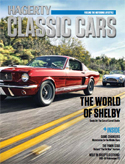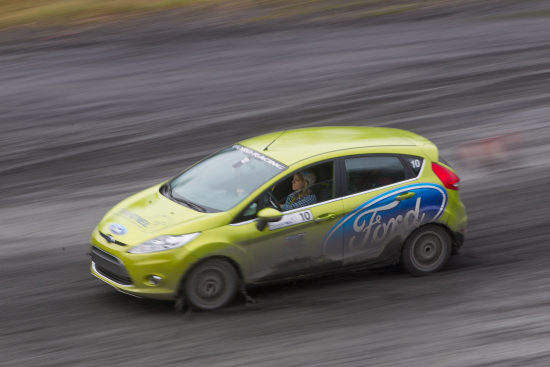Crash Course
Two Days of Adventure at Team O’Neil Rally School
I lead a singularly uninteresting life. I drive a white Volvo and own two cats. Like most people, I rarely have the opportunity to feel like a total badass.
So, when Hagerty Classic Cars Executive Editor Jonathan Stein offered me the chance to write a “New Experiences” story, I found myself declining options that seemed too tame.
Jonathan proposed operating giant construction equipment; I countered with a high-thrills flight in a vintage MiG. Jonathan sidestepped that idea, citing “logistics,” but returned with an acceptable alternative: rally school.
I’ve always been a cautious driver, a Sunday driver, even — the type who sets cruise control one mph under on the freeway. Jonathan referred to the whole experience as a “crash course” for me. I found the term off putting and said as much, because I’m pretty sure the words “driving school” and “crash” shouldn’t be used in the same sentence. Ever.
Still, I’d impulsively agreed to the proposition with only the barest understanding of rallying. After studying up, I found that at its most basic, rally racing is about skill, speed and endurance. Drivers navigate closed portions of public roads and trails in street-legal cars with the help of a co-driver, who uses an electronic odometer and route book to inform the driver of the terrain ahead. Rallies can cover hundreds of miles on every imaginable road surface and in all weather conditions, which is why rally drivers are considered some of the most skilled in the world.
I’d be learning from the best. Team O’Neil Rally School and Car Control Center (teamoneil.com) was founded in 1997 by five-time rally champion Tim O’Neil for students ranging from aspiring champs to those just seeking to become better drivers. Many of the instructors also have competition success under their belts. Students can sign up for a one-day “driving experience,” a five-day intensive course, or anything in between.
RALLY 101: INTRO TO THE BASICS
Tucked away in the White Mountains of New Hampshire, the school features miles of private unpaved roads, as well as a skid pad, slalom course and accident avoidance course.
At 9 a.m. sharp, we gathered in the classroom for our first lesson. Director of Training Chuck Long greeted us and gave us a brief introduction before showing us the “illustrious bright pink helmet,” which he referred to as a negative reinforcement tool; anyone who did something especially idiotic would be forced to wear it.
I secretly vowed that I wouldn’t do anything to merit that neon abomination.
There were 14 students in the class, split into two groups. My group consisted of three pairs: a father and son on vacation; two motorcycle racers from Ecuador; Miguel Barbery and Robert Ward — who were set to compete in the 2012 Rally America circuit; and me.
Introductions complete, we were led to a row of seemingly mild-mannered Ford Fiesta hatchbacks, in the unusual shade of “Lime Squeeze.” The battle-worn warriors were missing taillights, had tacked-on bumpers and showed various other cuts and bruises. These cars had seen the trenches of Team O’Neil Rally School.
The interiors were modified, with five-point seatbelts and roll cages for increased strength. I was suddenly distracted, imagining one of those shiny Fiestas wrapped around a tree, and a coworker’s words of farewell rang in my ears: “At least she didn’t have any dependents…”
Strapping in
Team O’Neil adheres to a 2:1 ratio of students to instructors. One student drives, with the instructor up front. The other student sits in back, and they swap after a few runs. Students also switch cars, so everyone gets a chance with each instructor. As the only one without a partner, I got plenty of one-on-one time.
After a few minutes fumbling with the harness, I was forced to turn to my first instructor, former New Hampshire State Trooper Mike Doucette, and confess that I had virtually zero experience driving a manual transmission, which was slightly problematic considering that none of the Fiestas had automatics. He shrugged and said he’d teach me in three simple steps: Slowly release the clutch until it begins to engage, then apply gas, then release the clutch the rest of the way. To my surprise, I was able to start in first gear — without stalling — for the first time, ever.
Our first course was the skid pad, a flat, gravel-studded ring. We were instructed to keep the car in second gear and maintain speed while circling the pad in order to understand the causes of understeer and oversteer skids. It was a serious lesson with practical implications, but it was extremely difficult to keep from grinning in sheer delight as I made my lurid green Fiesta slide around the skid pad.
Next we tried the slalom, a series of cones through which we wove our colorful fleet. The course was a sloppy mess, a dark gray mud/clay hybrid that spit into the air with each spin of the tires. The school preaches left-foot braking, which instructors said cuts braking time in half. As a 15-year-old first learning to drive, the concept seemed obvious — two pedals, two feet — but my parents quickly dissuaded me of that notion. Resuming the practice after more than a decade took some serious getting used to, but eventually I mastered smooth, even braking.
I was told to avoid the sharply cambered right side in one portion of the slalom. One student wasn’t so lucky, and slid his car right into the ditch, bending a front wheel. Once it was clear everyone was OK, I was relieved. Relieved that I wasn’t the one wearing the pink helmet, that is.
It wasn’t all smooth sailing. I was repeatedly chastised for using what instructor and rally champ Chris Duplessis called “The Soccer Mom,” an underhanded method of turning the wheel that was so ingrained I didn’t even notice I was doing it. “Do you drive a minivan stuffed with screaming kids?” he asked. “Then stop that! Hand over hand!”
On day two, we were introduced to pendulum turns, the steering and braking technique used to fling a rally car sideways through a turn. It was the lesson I’d been most eagerly anticipating after hours watching videos on YouTube. I was paired with Verena Mei, a rally driver with the TrueCar Racing Women Empowered Initiative, who’d be racing the TrueCar Fiesta with Team O’Neil and Star Girl Racing for the 2012 Rally America circuit. She was attending classes as a refresher for the upcoming season.
The pendulum turns were intimidating. In previous exercises, I’d pushed the car to what felt like an extremely irresponsible speed (ahem, 30 mph), but the pendulum course had the instructors ever-so-gently coaxing me outside of my comfort zone (“Go! Go! GO!”).
I didn’t nail it on the first try. Or the second, or the third. But the instructors were patient, and eventually I was whipping that little Fiesta around corners, shooting mud and gravel two feet into the air.
The first time I felt the back end slingshot the car around the turn was the most exhilarating moment of the whole experience, and I immediately sought to repeat the adrenaline rush. Perma-grin firmly in place and confidence suddenly ingrained, I ran the course again and again, leaving all of those Sunday driver tendencies in my dust once and for all.
Later in the afternoon, the students were shuffled around so everyone could focus on the type of vehicle he or she was most interested in. Verena and Miguel, who would both compete in the Rally America circuit in FWD cars, stuck to the Fiestas. I opted to try AWD and strapped into an ’80s-era Audi.
The dull red Audi exuded ominous swirls of white smoke from under its hood. One of the students from Ecuador had just had his way with it, and apparently he hadn’t been gentle. The Audi’s seat had no cushion, and I could adjust it forward only about halfway. At 5-foot-2, I was forced to drive nearly lying down, peering through the steering wheel. Distinctly non-badass, not to mention undignified. My instructor insisted I’d be fine.
He was right. I was immediately in my element with the Audi, which required a little more muscle to maneuver through the slalom. The car was a bit less responsive than the Fiesta, and I consequently felt more in control — enough to finally test the limits of the gas pedal, which I did gleefully. In fact, it was impossible to keep from laughing out loud as I tore through the course.
That exuberance led to my only real blunder, in which I took a pendulum turn a little too quickly and turned a little too late, decimating nearly all of the cones in the process, then stalling the car as I skidded to an unceremonious stop. “I think I just took out the cones” I said. “All of the cones,” Speechless, the instructor recovered quickly. “Yep,” he said. Did I mention these guys were patient?
Badass: Party of one
I left rally school with a cache of new tricks and some fleeting dreams of competing in my own Quattro. I’m not saying I’ve been practicing pendulum turns all over town; that would be reckless. But I’d be lying if I said I haven’t tried out one or two.
And while it may seem counterintuitive that a crash course would make me a better driver, the main benefit of the experience was a newfound confidence behind the wheel. That, and those pendulum turns.



